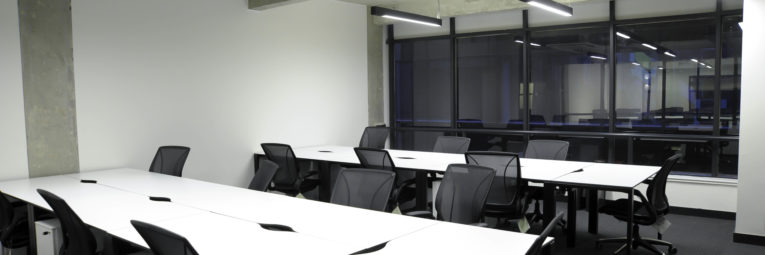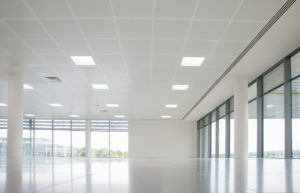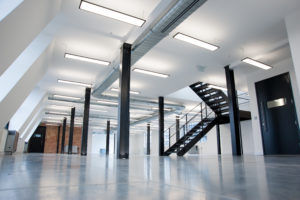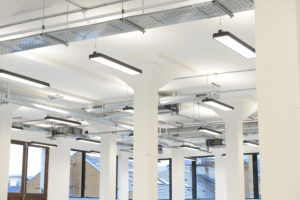
According to recent research by Savills, 87% of large UK offices will need to step up their game by 2030 to meet the minimum standards required for a Grade B Energy Performance Certificate (EPC) set by the Government in 2021.
Looking at that same stat through the other end of the telescope, that means only 13% of commercial landlords are currently doing enough. Some experts would argue that, unlike the government, climate change isn’t going to wait around for everyone to get their act together. The time for action is now.

For the benefit of those new to the business, EPCs are the UK Government’s scheme for rating the energy efficiency of buildings. The scheme is used for both the commercial and residential markets (if you’ve bought or sold a property any time since EPCs were introduced in 2007, you’ll know what we mean).
Certificates are issued by a qualified EPC assessor with a rating from A (very efficient) to G (inefficient). The assessor will inspect every part of the building, checking things like insulation, the size and construction of the property, heating, lighting and ventilation.
Currently, the landlord of a commercial building can only let a building if it meets the minimum required ‘Grade E’. However, landlords of buildings that reach this level cannot bumble along complacently thinking everything is fine. That’s because the Government has recently set a target of lifting the minimum energy efficiency of non-domestic buildings to ‘Grade B’ by 2030. The pressure is most definitely on.
Offices are ahead of many other real estate sectors in improving energy performance. This is because many office blocks are owned by institutional landlords with their own ESG strategies.
What’s more, with labelling systems such as BREEAM and LEED becoming increasingly common throughout the last 20 years, a rising proportion of all new build stock has been built to these standards. This trend continues, with 44% of central London office developments that started this year targeting a BREEAM rating of Very Good or above.
As lighting specialists, we’re focused on how new solutions in our field can contribute to the race to net zero for offices. Bearing in mind lighting consumes around 40% of the energy consumed by modern buildings, we have a big role to play.

For a start, simply switching to LED lighting solutions can make a telling difference. LEDs are more than twice the amount of light into a space, than traditional fluorescent sources, and multiply more than traditional tungsten sources.
The rapid advancement of LED light sources in modern lighting products manufactured today are so much more efficient than they used to be. It is now possible to achieve up to 200 lumens per watt at source and, correctly used, with modern optical materials you can still deliver impressive energy and, in turn, Carbon savings.
One argument sometimes used against LEDs is the cost, however, on a point for point replacement basis, the power consumed per point, to deliver the correct light level is significantly reduced and leads to rapid payback periods within 2 or 3 years, in some instances.
And the argument in favour of LEDs gets even stronger when you consider whole life costs. LEDs work out cheaper for your business over time since they last considerably longer. LEDs can operate for anything from 50,000 to 100,000 hours, reducing maintenance costs and interruptions to the workplace. This goes way further than the lifespan of traditional lighting sources which are predicted to fail somewhere between 1,000 and 30,000 hours. For large offices and other commercial spaces, the savings can be immense.
Incidentally, an additional benefit of the reduced power consumed by LEDs is a reduced heat gain to the space and results in significant savings from running cooling plant at lower levels.

Moving forward with the latest technologies, such as wireless Bluetooth controls, networked based communication and application based commissioning, in conjunction with tuneable LED technology can all have a positive effect on sustainability as well as for the wellbeing of your employees. Another advantage of this approach means that the building does not need re-wiring, reducing cost and disruption during the installation.
And while some light sources becomes less efficient when they are dimmed, LEDs become more efficient and end up lasting longer, as they run at lower temperatures.
Climate change is a monumental global issue, but all of us taking small steps in the right direction can provide positive change on an epic scale. Start making the necessary changes today and that 2030 deadline still seems a reassuringly long way away.
If you would like friendly no-obligation advice on sustainable lighting solutions, or anything else to do with lighting for commercial buildings, please get in touch.
I can rely on Phi being proactive on issues arising.
Relationships & Empathy
Phi understands us, our scope and our limitations.
Relationships & Empathy
Phi delivers a good solution, which is more than just a product. Their service is good, they talk through schemes with us and there is more to it than just a catalogue.
Technical Skills
The main asset of Phi is people and the high level of technical backup they provide. For example with their competitors I meet a salesman and not a technical salesman. This difference is crucial.
Technical Skills
Good quality products at a reasonable price.
Price
Phi is not the cheapest supplier but they offer quality architectural fittings.
Price
Phi’s personal service is appreciated and differentiates them.
Service
During completed projects, we have been happy with the performance and communication from Phi. I can rely on Phi being proactive on issues arising.
Service
I see Phi for architectural led office foyers, reception areas, bespoke spaces in office blocks and good architectural lighting for commercial developments
Spaces
Appropriate for the commercial sector in particular and other places where there is a modern style requirement as befits their current product range.
Spaces
Phi is most suited to commercial offices, associated rooms and educational buildings.
Spaces
Phi delivers a good solution, which is more than just a product.
Perception & Image
We are project focused; there are lots of people in the industry but it is questionable whether they want to help and support properly. Why change to someone who may let you down, you stick with the best.
Perception & Image
Phi is not mainstream but a specialist niche architectural supplier who is a little bit different.
Perception & Image
Phi offer support, which sets them apart.
Perception & Image
Phi is a strong quality architectural supplier, giving good advice where we are lacking.
Perception & Image
Phi offer a great level of experience, supply, service and back up.
Perception & Image
I can rely on Phi being proactive on issues arising.
Relationships & Empathy
Phi understands us, our scope and our limitations.
Relationships & Empathy
Phi delivers a good solution, which is more than just a product. Their service is good, they talk through schemes with us and there is more to it than just a catalogue.
Technical Skills
The main asset of Phi is people and the high level of technical backup they provide. For example with their competitors I meet a salesman and not a technical salesman. This difference is crucial.
Technical Skills
Good quality products at a reasonable price.
Price
Phi is not the cheapest supplier but they offer quality architectural fittings.
Price
Phi’s personal service is appreciated and differentiates them.
Service
During completed projects, we have been happy with the performance and communication from Phi. I can rely on Phi being proactive on issues arising.
Service
I see Phi for architectural led office foyers, reception areas, bespoke spaces in office blocks and good architectural lighting for commercial developments
Spaces
Appropriate for the commercial sector in particular and other places where there is a modern style requirement as befits their current product range.
Spaces
Phi is most suited to commercial offices, associated rooms and educational buildings.
Spaces
Phi delivers a good solution, which is more than just a product.
Perception & Image
We are project focused; there are lots of people in the industry but it is questionable whether they want to help and support properly. Why change to someone who may let you down, you stick with the best.
Perception & Image
Phi is not mainstream but a specialist niche architectural supplier who is a little bit different.
Perception & Image
Phi offer support, which sets them apart.
Perception & Image
Phi is a strong quality architectural supplier, giving good advice where we are lacking.
Perception & Image
Phi offer a great level of experience, supply, service and back up.
Perception & Image
Phi Lighting Ltd
Unit 9, Brook Business Park, Brookhampton Lane, Kineton, CV35 0JA
Phone: +44 (0)1926 640 366Fax: +44 (0)1926 641 747Email: quotes@phi-lighting.com
Phone: +44 (0)203 875 6484
